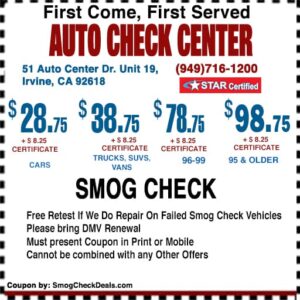Smog Check and Auto Repair of Irvine, CA is a complete low cost auto repair station and is a state licensed Smog Check Station. Our technicians are Automotive Service Excellence Certified ( ASE Certified ). We provide service on all cars and trucks – domestic cars and foreign cars. Our station does complete auto electrical work and complete auto troubleshooting. Auto Check Center – Smog Check and Auto Repair is state certified for Brake and Lamp Certification for Salvaged Vehicles and is licensed to perform these inspections. Registering for vehicles in the State of California with a Salvaged Title DMV requires a Brake and Lamp Inspection Certification in order for the owner to obtain title – we can help you get your title.
Archives for October 2011
Auto Smog Check
Coupon
How to pass Smog Test
Every two years, California vehicle owners face having to submit their car to smog test. To prepare for the test, Smog Check Irvine recommends five things that can make the difference between passing and failing the test.
Step 1 – Change the Oil and Oil, Air, and Gas Filters
Dirty oil causes bad emissions to come through on the test. In addition to changing the oil, be sure to change the oil filter. Change the air filter for optimal results. If the fuel filter is over five years old, it also needs to be changed.
Step 2 – Check the Positive Crankcase Valve (PVC)
Give the PVC a shake. If it clicks, then it is working fine. If not, it needs to be changed.
Step 3 – Change the Spark Plugs
If the spark plugs appear dirty or worn, they probably need to be changed. When checking the spark plugs, don’t forget to check the wires as well. If they are looking worn, they might also need to be replaced.
Step 4 – Check for Leaks
Check all of the hoses in your engine compartment, especially vacuum lines. If there are any that show wear, replace them. Look for oil leaks. If there is oil on the engine, it means the vehicle is losing oil pressure and emissions are going to be off. Many times oil leaks result from failed gaskets, which must be replaced.
Check for exhaust leaks. To do this, simply start the vehicle and rev up the engine. If the muffler sounds unusually loud, then there is probably an exhaust leak that needs to be fixed.
Step 5 – Bring the Vehicle in Warm
One final thing you can do the day of the test is to drive the car fifteen minutes on the freeway, and then fifteen minutes on the city streets before bringing it in for the test.
Update on Smog Check Laws
During 2010, the California State Legislature approved a number of new laws of interest to Automobile Club of Southern California members and motorists. Unless otherwise noted, these measures take effect January 1, 2011.
Local Tickets. SB 949, supported by the Auto Club to clarify existing law, makes it unlawful for local governments to ticket drivers who commit moving violations under municipal codes or other local regulations. All moving violations must be cited under the appropriate state vehicle code section, which specifies penalties. This law ensures that drivers throughout the state will be treated uniformly for moving violations.
Smog Check. Under AB 2289, beginning sometime after January 1, 2013, model-year 2000 and newer vehicles will be tested for smog compliance using the vehicle’s onboard diagnostic systems (OBD-II) instead of a tailpipe sensor. If the vehicle is not equipped with OBD-II or has emissions problems, it can be tested using the tailpipe sensor at a test-only station. Changing the testing procedure should reduce the cost of smog checks, according to the California Bureau of Automotive Repair.
Source: January/February 2011 Edition of Westways Magazine
An emission test cycle, also known as a smog check, is a specified procedure for measuring pollutant emissions of engines. For emission measurements to be comparable for different engines in a category, the measurements are performed under a specific operating pattern, or ‘test cycle’ of alternating high, medium, and low engine load. The test cycle should ideally reflect a ‘normal’ usage pattern concerning speed and acceleration. Realistic test cycles are instrumental for the environmental integrity of emission standards. It was recently discovered that engine manufacturers would engage in ‘cycle beating’ to optimize emission performance to the test cycle against which European vehicle emission standards were tested, with the result that real-life emissions would be much higher than expected, undermining the standards and public health.
Print Smog Test Coupon and save $31 for your smog test.






